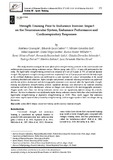Mostrar el registro sencillo del ítem
Strength training prior to endurance exercise: impact on the neuromuscular system, endurance performance and cardiorespiratory responses
| dc.creator | Conceição, Matheus | es_ES |
| dc.creator | Lusa Cadore, Eduardo | es_ES |
| dc.creator | González Izal, Miriam | es_ES |
| dc.creator | Izquierdo Redín, Mikel | es_ES |
| dc.creator | Liedtke, Giane Veiga | es_ES |
| dc.date.accessioned | 2020-09-07T08:46:38Z | |
| dc.date.available | 2020-09-07T08:46:38Z | |
| dc.date.issued | 2014 | |
| dc.identifier.issn | 1899-7562 | |
| dc.identifier.uri | https://hdl.handle.net/2454/38051 | |
| dc.description.abstract | This study aimed to investigate the acute effects of two strength-training protocols on the neuromuscular and cardiorespiratory responses during endurance exercise. Thirteen young males (23.2 ± 1.6 years old) participated in this study. The hypertrophic strength-training protocol was composed of 6 sets of 8 squats at 75% of maximal dynamic strength. The plyometric strength-training protocol was composed of 6 sets of 8 jumps performed with the body weight as the workload. Endurance exercise was performed on a cycle ergometer at a power corresponding to the second ventilatory threshold until exhaustion. Before and after each protocol, a maximal voluntary contraction was performed, and the rate of force development and electromyographic parameters were assessed. After the hypertrophic strengthtraining and plyometric strength-training protocol, significant decreases were observed in the maximal voluntary contraction and rate of force development, whereas no changes were observed in the electromyographic parameters. Oxygen uptake and a heart rate during endurance exercise were not significantly different among the protocols. However, the time-to-exhaustion was significantly higher during endurance exercise alone than when performed after hypertrophic strength-training or plyometric strength-training (p <0.05). These results suggest that endurance performance may be impaired when preceded by strength-training, with no oxygen uptake or heart rate changes during the exercise. | en |
| dc.description.sponsorship | This work was supported by the CNPQ, CAPES and FAPERGS Government Associations. | en |
| dc.format.extent | 11 p. | |
| dc.format.mimetype | application/pdf | en |
| dc.language.iso | eng | en |
| dc.publisher | De Gruyter | en |
| dc.relation.ispartof | Journal of Human Kinetics, 2014, 44(1), 171-181 | en |
| dc.rights | Creative Commons Attribution-NonCommercial-NoDerivs 3.0 Unported (CC BY-NC-ND 3.0) | en |
| dc.rights.uri | http://creativecommons.org/licenses/by-nc-nd/3.0/ | |
| dc.subject | Surface EMG | en |
| dc.subject | Fatigue | en |
| dc.subject | Concurrent training | en |
| dc.subject | Aerobic exercise | en |
| dc.subject | Maximal strength | en |
| dc.title | Strength training prior to endurance exercise: impact on the neuromuscular system, endurance performance and cardiorespiratory responses | en |
| dc.type | info:eu-repo/semantics/article | en |
| dc.type | Artículo / Artikulua | es |
| dc.contributor.department | Ciencias de la Salud | es_ES |
| dc.contributor.department | Osasun Zientziak | eu |
| dc.rights.accessRights | info:eu-repo/semantics/openAccess | en |
| dc.rights.accessRights | Acceso abierto / Sarbide irekia | es |
| dc.identifier.doi | 10.2478/hukin-2014-0123 | |
| dc.relation.publisherversion | https://doi.org/10.2478/hukin-2014-0123 | |
| dc.type.version | info:eu-repo/semantics/publishedVersion | en |
| dc.type.version | Versión publicada / Argitaratu den bertsioa | es |



